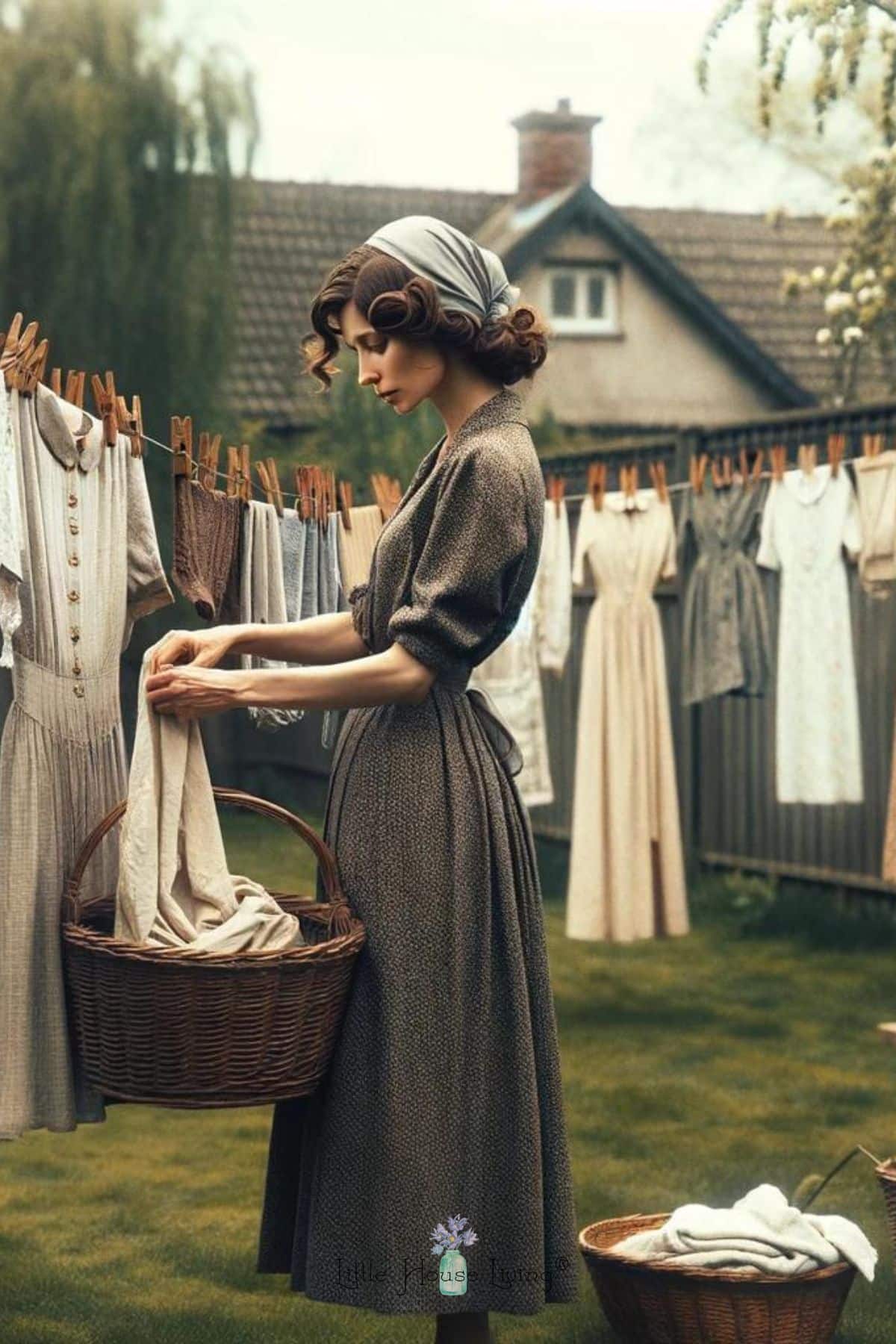15 Depression Era Frugal Laundry Tips
This post may contain affiliate links. Read our disclosure policy here.
Ever wonder how our grandparents managed to keep their clothes pristine during the tough times of the Great Depression? It turns out they had some ingenious tricks up their sleeves. In this article, we’re stepping back in time to uncover frugal laundry tips from the Depression era that not only helped stretch the budget but also ensured clothes stayed spick and span.

Let’s dive right into to all of the tips! Don’t forget to share this article with your friends who are looking to cut costs.
Depression-Era Frugal Laundry Tips

1. Homemade Soap
In the Depression era, store-bought laundry detergents were a luxury many couldn’t afford. Instead, resourceful individuals turned to making their own soap.
A simple concoction of lye, fat, and water was typically used. While you might not be keen on crafting soap from scratch, exploring DIY laundry soap recipes using readily available ingredients can be a cost-effective and eco-friendly alternative.
Here’s how my mom makes Homemade Laundry Soap.
2. Handwashing
Washing machines were nowhere in sight during the Depression, and people relied on good, old-fashioned handwashing using a washboard or a basin.
Although it would take more effort than washing machines, handwashing will help save energy and money. Give it a go – you might discover a newfound appreciation for the manual approach to laundry.
3. Minimal Detergent Usage
In the era of the Great Depression, every drop counted, and that included detergent. Families were experts at making their cleaning products last longer by using them sparingly.
One popular approach was to dilute the detergent with water before using it, which not only stretches the detergent but also ensures an even distribution, preventing any residue buildup on the clothes.
Additionally, you can pre-soak heavily soiled items to minimize the need for excessive detergent during the main wash.
4. Cold Water Wash
Hot water was considered a precious commodity during the Depression, reserved for essential needs.
This scarcity led to the widespread adoption of cold water washing for laundry. Apart from being a frugal choice, it also helps preserve the colors of your clothes.
Consider using the cold water setting on your washing machine occasionally, and you’ll save on energy costs and extend the life of your garments.

5. Sun Drying
Before the invention of electric dryers, people harnessed the sun’s power to dry their clothes.
Hanging clothes on a line outside saved money and provided a natural freshness that no dryer sheet could replicate. So, take a cue from the past and consider setting up a clothesline in your backyard or balcony.
Here’s my Year-Round Laundry Routine without a dryer.
6. Reuse Water
In the spirit of conservation, Depression-era households didn’t let a drop of water go to waste.
After washing clothes, they repurposed the water for other household chores. This practice minimized water wastage and showcased a resourcefulness that is often overlooked today.
Implementing a similar strategy in your household, such as using laundry water for mopping floors or watering plants, can contribute to frugality and environmental responsibility.
If you use a Grey water-friendly laundry detergent (I use Ecos), you can have something that’s plant-safe.
7. Patch and Mend
In times when every piece of clothing was a valuable asset, throwing things away due to minor damage was out of the question. Sewing skills were essential, as individuals would repair small holes, tears, or loose seams to extend the lifespan of their garments.
Embrace this frugal practice by learning some basic sewing techniques, and you’ll not only save money but also contribute to reducing textile waste.
8. Rotate and Share Clothes
Wardrobes were limited during the Depression, and families often rotated and shared their clothing. Rather than constantly buying new items, they maximized the use of existing garments.
Adopting a similar mindset today involves rethinking the need for a constantly expanding wardrobe. Rotate your clothes seasonally, share items among family members or friends, and discover the joy of making the most of what you already have.
You can do this easily by having a Clothing Swap.

9. Homemade Fabric Softener and Odor Removers
Forget expensive fabric softeners and odor removers. Depression-era households turned to simple and budget-friendly alternatives like baking soda and vinegar.
Adding a small amount of baking soda to your laundry can help soften clothes, while vinegar acts as a natural deodorizer. This dynamic duo provides cost-effective results and eliminates the need for chemical-laden products, promoting a more eco-friendly laundry routine.
Here’s how I make Homemade Fabric Softener.
10. Homemade Starch
Starching clothes for that crisp, freshly pressed look was common during the Depression. However, households often made their own using water and cornstarch rather than purchasing commercial starch.
Try out your hand at making your starch to achieve that classic, polished appearance without breaking the bank. Here’s a simple DIY.
11. Use Mesh Bags for Delicates
To protect delicate items during washing, Depression-era households often used mesh bags. These bags prevented snagging and stretching, extending the life of delicate fabrics.
Invest in a few mesh bags for your delicates, and you’ll reduce the risk of damage during the washing process.
12. DIY Fabric Freshener
Depression-era homemakers were masters at making do with what they had. Instead of splurging on store-bought fabric fresheners, they crafted their own using readily available ingredients.
Mix water with a few drops of essential oils like lavender or lemon for a budget-friendly alternative that keeps your clothes smelling delightful.
Here’s how to easily make your own Fabric Refresher.
13. Line Your Drawers with Soap
Keeping clothes smelling fresh was a priority, even in tough times. To achieve this, individuals would line their drawers with bars of soap so that the subtle fragrance would transfer to the clothing, providing a natural and long-lasting freshness.
Consider adopting this old-school trick for a fragrant wardrobe without the need for artificial scents or laundry detergent add-ins.
14. DIY Dryer Balls
Electric dryers were a luxury during the Depression, but if you use one today, consider making your own dryer balls by rolling up old socks or wrapping tennis balls in fabric scraps.
These DIY dryer balls reduce drying time, save energy, and act as a cost-effective alternative to commercial dryer sheets.
If you already have them, here’s How To Refresh Dryer Balls.

15. Family Effort
Laundry Day in the Depression Era wasn’t a one-person show but a family event. Everyone, from the little ones to the grown-ups, had a role. Kids helped sort clothes or carry water while the older folks handled the heavier tasks.
While it might not be practical today for the whole family to do laundry together, the idea of sharing the load is great.
There you have it—15 Depression Era Frugal Laundry Tips that prove necessity truly is the mother of invention. Try these tips and see how they can make a difference in your laundry routine. Happy laundering!
More Frugal Living Tips
- Frugal Laundry Tips & Strategies – A Comprehensive Look
- Frugal Living Tips from Our Grandparents
- My Year Around Laundry Routine Without a Dryer
- 23 Frugal Living Tips from the Great Depression You Need to Know
Have you tried any of these tips before?

Merissa Alink
Merissa has been blogging about and living the simple and frugal life on Little House Living since 2009 and has internationally published 2 books on the topic. You can read about Merissa’s journey from penniless to freedom on the About Page. You can send her a message any time from the Contact Page.
This blog post with Depression Era Frugal Laundry Tips was originally posted on Little House Living in February 2024.



Thanks for the great tips, I already do the clothes line and dryer balls and mend our clothes. I think I’ll try the fabric softener idea! I so enjoy reading your articles.
I learned interesting things from the maintenance man that had come out to install an appliance. He told me that we really only need to use about a tablespoon of detergent in the washing machine. I was skeptical, but when I tried it, worked great! I pre treat stains to put a bit of extra power on it. Also, he said that the re emergence of homemade detergents, while sometimes nice in theory, has to be watched. He pointed out the clothes and things that make stains aren’t necessarily made the same as they were years ago so stains may not come out or they might not get clean. Also, depending on the ingredients, they are seeing a rise in plumbing issues because sometimes they can gunk up the systems including the appliance. He also mentioned about bacteria growth in cleaners because there are no preservatives (you also need to be very careful with homemade toiletries and room sprays) and the vinegar most people use to make things isn’t strong enough to kill bacteria (we tend to all use the store bought stuff, there is a much more acidic one for potential germ killing) That said, not to discourage from making homemade, just stuff to keep in mind. Homemade is great( I do as much as possible) but watch what is going in it. thanks for the great tips!
My grandparents lived through both world wars, the great depression and the Spanish flu pandemic of 1918-20. My parents grew up during the great depression and WW2. Life was very hard in NE England due to rationing and limited income earned in the coal mines due to strikes and shut downs. So I learned frugality from 2 generations. While I don’t employ all the tips I learned I have used many over the years to stretch our budget. When my 4 boys were young, clothes were handed down. I would also swap with neighbours and friends for clothes. I buy a lot of second hand clothes for hubby and self or we wait until end of season sales. We drive a very old SUV and plan to drive it as long as possible. With one exception we have always only had one car and it was second hand. While I didn’t have any knowledge at the time about making my own laundry detergent, I would use half of what the instructions said and the clothes still came out clean. I’ve been using dryer balls for years. If I used dryer sheets I would cut them into thirds to stretch the box further and it still seemed to work. I’ve learned to repurpose leftovers, repair clothes or reuse portions of clothes for other purposes. Furniture or parts of furniture also gets repurposed and made into something else.